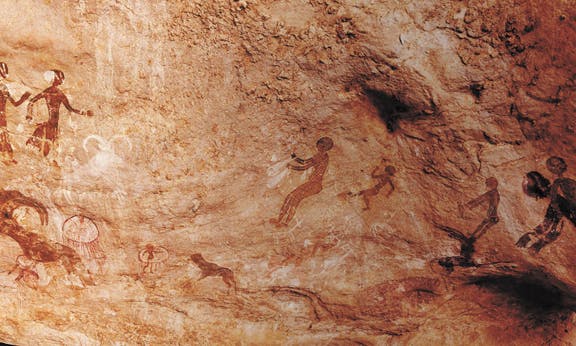Pre-colonial society shows humans can live collectively

“If the test of sophistication were whether or not all were fed regardless of rank or whether all contributed to the spiritual and cultural health of the civilisation, Aboriginal Australia might have a much higher rank than some of the nations considered the hallmark of human evolution.”
So wrote Bruce Pascoe in his intriguing book Dark Emu, which shows, contrary to the dominant assumptions, that pre-invasion Aborigines were not simply hunter-gatherers, but employed sophisticated production techniques and were partly sedentary.
This is important knowledge, because it debunks the prevalent assumption of anthropologists, until recently, that only nomadic hunter-gatherers lived in egalitarian societies based on collective reciprocity.
Large swathes of what the British colonial invaders assumed were wild grasses were actually being cultivated and harvested. With careful use of fire, Aborigines controlled areas for grain production or meadows of yams and other vegetables, intersecting with forests for animals.
They terraced land to control water flows and prevent erosion, and built irrigation systems even in the extremes of central Australia. In the Port Phillip area about 1840, when settlers began ploughing, local Aborigines rushed in and began hoeing across their furrows, clearly worried that the newcomers would cause erosion.
Ancient fish traps, possibly 40,000 years old, a half-kilometre long complex of dry-stone walls and holding ponds at Brewarrina in north-west New South Wales are famous. They are arranged in an innovative way to allow fish to be herded and caught during both high and low river flows.
What is less well known is that similar structures and weirs for managing fish stocks existed all down the Darling River and the Murray. Most have been destroyed. Aboriginal people sewed intricate nets, which they strung across the Darling – until paddle steamers carrying wool from sheep stations made it impossible.
Even less well known is that the traps and weirs encapsulate collective responsibility and shared access to resources.
They allowed breeding stock through to continue up the river, catching just sufficient for local needs. Families or clan groups had responsibilities for different aspects, all coordinating to ensure there was enough for everyone up and down this vast system of thousands of interconnected creeks and rivers. In this cooperative culture, the rivers sustained thousands of people for tens of thousands of years.
The lie of terra nullius was established by destroying the evidence of all this.
In diaries and letters, early invaders recorded detailed descriptions of Aboriginal activity, their houses and large stores of grain.
But they not only trampled the productive meadows with their sheep, cattle and horses – they deliberately destroyed what they wrote about. Houses were burned and stones and logs stolen for structures that suited the invaders.
They could not incorporate the significance of what they encountered into their blinkered world view.
George Grey in 1839 described houses built with large logs near the Gasgoyne River in Western Australia. He documented cultivation and harvesting of yams across fields of five or six kilometres and paths along which were wells three to four metres deep, which in his words were “executed in a superior manner”.
“[M]ore had been done to secure provisions from the ground by manual labour than I could believe it in the power of uncivilised man to accomplish”, he concluded.
Some saw them as signs that there had been a “civilised” society which predated the present one.
In descriptions of large, well-constructed buildings, they referred to “huts” or “humpies”. When remarking on grain being threshed and the production of a surplus, they called it producing “for subsistence”.
In Sunbury, Victoria, within a few years, no Europeans could explain the ridges in the ground, which were the remains of terracing to facilitate crop farming.
Europeans built fences and erected borders, reflecting the divisions created by individual ownership and competition. They made the Aborigines’ use of fire, which depended on cooperation from one ecosystem to another, impossible.
Bill Gammage, author of The Biggest Estate on Earth: how Aborigines made Australia, argues that “the power of Aboriginal spiritual sanctions” guaranteed that crops would not be interfered with by other clans. So they could leave an area, knowing their homes and crops would be there untouched when they returned from travelling often long distances for hunting or cultural, social and trading activities.
They combined settlements with nomadic customs, something now known to have become common around the world 20-40,000 years ago. To the invaders, empty buildings couldn’t be “houses”. They simply burned and destroyed them along with the cultivation that produced the stores of grain they stole.
The most recent knowledge of Aboriginal society is important because it adds to the evidence it was not only our forager ancestors, barely separate from the apes, who lived collectively without class divisions.
It strengthens the argument that a future society of equality and decency is not a utopian dream, but something worth fighting for.